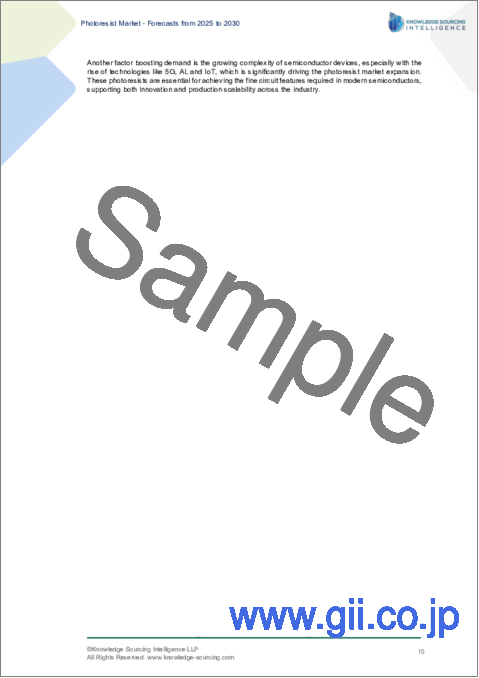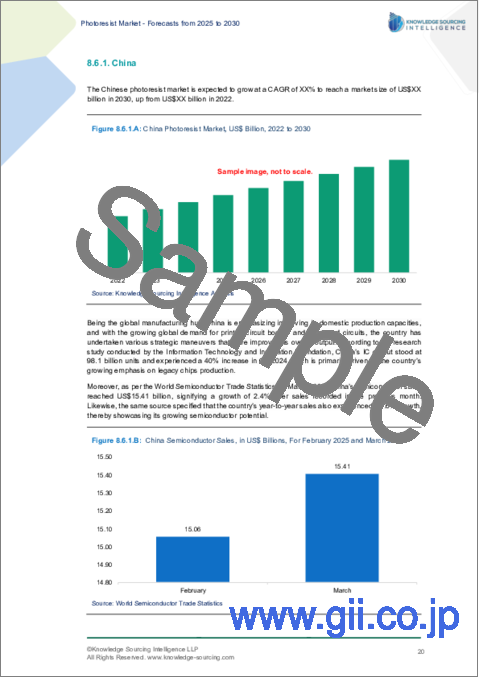|
|
市場調査レポート
商品コード
1604538
フォトレジスト市場:将来予測 (2025年~2030年)Photoresist Market - Forecasts from 2025 to 2030 |
||||||
カスタマイズ可能
|
|||||||
| フォトレジスト市場:将来予測 (2025年~2030年) |
|
出版日: 2024年11月11日
発行: Knowledge Sourcing Intelligence
ページ情報: 英文 142 Pages
納期: 即日から翌営業日
|
- 全表示
- 概要
- 目次
フォトレジスト市場は6.13%のCAGRで成長し、市場規模は2025年の53億2,400万米ドルから2030年には67億5,400万米ドルに達すると予測されます。
フォトレジスト市場は複数の要因によって牽引されています。自動車産業はフォトレジスト市場を牽引する顕著な産業であり、これらの材料は車載用途に使用されます。さらに、電子機器の需要拡大が予測期間中の発展にプラスの影響を与えると思われます。
ハードウェアや電気機器向けの半導体産業の発展が市場成長に有利に働くと思われます。量子コンピュータ、人工知能、機械学習、ブロックチェーンなど、今後の現代技術はフォトレジスト市場の発展をさらに拡大させます。
- 自動車産業は、フォトレジストが利用される著名なエンドユーザー産業です。IEA (国際エネルギー機関) によると、2021年のEV販売台数は470万台で、2022年には730万台、2023年には950万台に増加します。
- 半導体産業協会によると、2020年1月から2022年1月の間に、世界の産業界は月産400万ウエハーの製造能力を追加し、20%以上増加すると予測されています。
フォトレジスト市場の促進要因
- 半導体セグメントからの需要拡大
フォトレジストは感光性ポリマーです。半導体で使用されるフォトレジストは、露光すると構造が変化する感光性ポリマーです。メモリー、ロジック、アナログ、MPUなどに利用され、半導体産業は急成長しています。半導体産業協会 (SIA) によると、2024年5月の業界売上高は491億米ドルに達し、2023年5月の合計412億米ドルと比べ19.3%増加しました。
半導体産業は、医療機器、医療、通信、コンピューティング、防衛・航空宇宙、輸送・インフラ、エネルギー、そして人工知能・量子コンピューティング・高度ワイヤレスネットワークなどの将来技術の進歩を可能にしました。このような半導体の活用領域の拡大は、フォトレジスト材料の需要につながります。
フォトレジスト市場の地理的展望
- フォトレジスト市場は世界の5つの地域に区分されます。
地域別に見ると、フォトレジスト市場は北米、南米、欧州、中東・アフリカ、アジア太平洋に区分されます。アジア太平洋は、中国、日本、インド、韓国などの主要経済国が支配的です。急成長している新興国の中には、ASEAN諸国などこの地域のものもあります。
アジア太平洋は、コンシューマー・エレクトロニクスの増加により、フォトレジスト市場の急成長が見込まれています。インドのエレクトロニクス製品の国内生産は、2017年度の490億米ドルから13%のCAGRで増加し、23年度には1,010億米ドルに達しました。Invest Indiaによると、同国の電子機器輸出額は26年度までに1,200億米ドルに達すると予想されています。北米は、人工知能や量子コンピューティングの活用が進んでいるため、フォトレジスト材料で大きな市場シェアを占めると予想されます。
当レポートを購入する理由
- 洞察に満ちた分析:顧客セグメント、政府政策と社会経済要因、消費者の嗜好、産業別、その他のサブセグメントに焦点を当て、主要地域だけでなく新興地域もカバーする詳細な市場考察を得ることができます。
- 競合情勢:世界の主要企業が採用している戦略的作戦を理解し、適切な戦略による市場浸透の可能性を理解することができます。
- 市場促進要因と将来動向:ダイナミックな要因と極めて重要な市場動向、そしてそれらが今後の市場展開をどのように形成していくかを探ります。
- 行動可能な提言:ダイナミックな環境の中で、新たなビジネスストリームと収益を発掘するための戦略的意思決定に洞察を活用します。
- 幅広い利用者に対応:新興企業、研究機関、コンサルタント、中小企業、大企業にとって有益で費用対効果が高いです。
どのような用途で利用されていますか?
業界・市場考察、事業機会評価、製品需要予測、市場参入戦略、地理的拡大、設備投資決定、規制の枠組みと影響、新製品開発、競合の影響
分析範囲
- 過去のデータと予測 (2022~2029年)
- 成長機会、課題、サプライチェーンの展望、規制枠組み、顧客行動、動向分析
- 競合企業のポジショニング・戦略・市場シェア分析
- 収益成長率と予測分析:セグメント別・地域別 (国別)
- 企業プロファイリング (戦略、製品、財務情報、主な動向など)
目次
第1章 イントロダクション
- 市場概要
- 市場の定義
- 調査範囲
- 市場セグメンテーション
- 通貨
- 前提条件
- 基準年と予測年のタイムライン
- 利害関係者にとっての主なメリット
第2章 分析手法
- 分析デザイン
- 分析プロセス
第3章 エグゼクティブサマリー
- 主な調査結果
- アナリストの見解
第4章 市場力学
- 市場促進要因
- 半導体分野からの需要増加
- 電子機器市場からの需要が高い
- 市場抑制要因
- ポーターのファイブフォース分析
- 業界バリューチェーン分析
第5章 フォトレジスト市場:種類別
- イントロダクション
- ArF液浸
- ArFドライフィルム
- KrF
- Gライン・Iライン
- その他
第6章 フォトレジスト市場:用途別
- イントロダクション
- 半導体
- 液晶ディスプレイ (LCD)
- プリント回路基板 (PCB)
- その他
第7章 フォトレジスト市場:エンドユーザー産業別
- イントロダクション
- 電気・電子
- 自動車
- 包装
- その他
第8章 フォトレジスト市場:地域別
- 世界概要
- 北米
- 米国
- カナダ
- メキシコ
- 南米
- ブラジル
- アルゼンチン
- その他南米
- 欧州
- 英国
- ドイツ
- フランス
- イタリア
- スペイン
- その他欧州
- 中東・アフリカ
- サウジアラビア
- アラブ首長国連邦
- その他中東・アフリカ
- アジア太平洋
- 中国
- インド
- 日本
- 韓国
- 台湾
- タイ
- インドネシア
- その他アジア太平洋
第9章 競合環境と分析
- 主要企業と戦略分析
- 市場シェア分析
- 企業合併・買収 (M&A)、合意、事業協力
- 競合ダッシュボード
第10章 企業プロファイル
- ALLRESIST GmbH
- Asahi Kasei Corporation
- DJ Microlaminates
- DuPont
- FUJIFILM Holdings America Corporation
- JSR Corporation.
- Microchemical GmbH
- Shin-Etsu Chemical Co., Ltd
- Sumitomo Chemical Co., Ltd.
- TOKYO OHKA KOGYO CO., LTD.
- LG Chem
- Mitsui Chemicals Inc
- Merck KGaA
- Everlight Chemical Industrial Co.
The photoresist market is expected to grow at a CAGR of 6.13%, reaching a market size of US$6.754 billion in 2030 from US$5.324 billion in 2025.
The market for the photoresist is driven by multiple factors. The automobile industry is a prominent industry that would drive the photoresist market, where these materials are used for in-vehicle applications. Further, the growing demand for electronic equipment will positively impact this market's development over the forecast period.
Developing semiconductor industry for hardware and electrical equipment is supposed to be advantageous for market growth. The upcoming modern-age technology, such as quantum computers, artificial intelligence, machine learning, blockchain, etc., further enlarges the photoresist market development.
- The automobile industry is a prominent end-user industry where photoresist is utilized. According to the IEA (International Energy Agency), EV sales had been 4.7 million in 2021, rising to 7.3 million in 2022 and 9.5 million in 2023.
- According to the Semiconductor Industry Association, between January 2020 and January 2022, the global industry is projected to have added enough manufacturing capacity to produce an additional 4 million wafers per month, an increase of over 20%.
Photoresist market drivers
- Growing demand from the semiconductor segment
A photoresist is a light-sensitive polymer. The photoresists used in semiconductors are light-sensitive polymers that change their structure when exposed. The semiconductor industry is witnessing a sharp increase as it is being utilized in memory, logic, analog, and MPU. According to the Semiconductor Industry Association (SIA), industry sales hit $49.1 billion during May 2024, an increase of 19.3% compared to the May 2023 total of $41.2 billion.
The semiconductor industry enabled advances in medical devices, health care, communications, computing, defense and aerospace, transportation and infrastructure, energy, and future technology such as artificial intelligence, quantum computing, and advanced wireless networks. These increased applications of the semiconductor would lead to the demand for photoresist materials.
Photoresist market geographical outlooks
- The photoresist market is segmented into five regions worldwide
By geography, the photoresist market is segmented into North America, South America, Europe, the Middle East and Africa, and Asia Pacific. The major economies like China, Japan, India, and South Korea dominate the Asia-Pacific region. Some of the fastest-growing emerging economies are from this region, such as ASEAN countries.
The Asia Pacific region is expected to see the fastest growth in the photoresist market due to increasing consumer electronics. India's domestic production of electronics products increased at a CAGR of 13% from $49 Bn in FY17 to $101 Bn in FY23. The country's electronics export is expected to reach $120 Bn by FY26, according to Invest India. North America is expected to have a significant market share for photoresist material due to its major utilization of artificial intelligence and quantum computing.
Reasons for buying this report:-
- Insightful Analysis: Gain detailed market insights covering major as well as emerging geographical regions, focusing on customer segments, government policies and socio-economic factors, consumer preferences, industry verticals, other sub- segments.
- Competitive Landscape: Understand the strategic maneuvers employed by key players globally to understand possible market penetration with the correct strategy.
- Market Drivers & Future Trends: Explore the dynamic factors and pivotal market trends and how they will shape up future market developments.
- Actionable Recommendations: Utilize the insights to exercise strategic decision to uncover new business streams and revenues in a dynamic environment.
- Caters to a Wide Audience: Beneficial and cost-effective for startups, research institutions, consultants, SMEs, and large enterprises.
What do businesses use our reports for?
Industry and Market Insights, Opportunity Assessment, Product Demand Forecasting, Market Entry Strategy, Geographical Expansion, Capital Investment Decisions, Regulatory Framework & Implications, New Product Development, Competitive Intelligence
Report Coverage:
- Historical data & forecasts from 2022 to 2030
- Growth Opportunities, Challenges, Supply Chain Outlook, Regulatory Framework, Customer Behaviour, and Trend Analysis
- Competitive Positioning, Strategies, and Market Share Analysis
- Revenue Growth and Forecast Assessment of segments and regions including countries
- Company Profiling (Strategies, Products, Financial Information, and Key Developments among others)
The photoresist market is segmented and analyzed as follows:
By Type
- ArF Immersion
- ArF Dry Film
- KrF
- G-Line & I-line
- Others
By Application
- Semiconductors
- Liquid Crystal Displays (LCDs)
- Printed Circuit Boards (PCBs)
- Others
By End-user Industry
- Electricals and Electronics
- Automobiles
- Packaging
- Others
By Geography
- North America
- USA
- Canada
- Mexico
- South America
- Brazil
- Argentina
- Rest of South America
- Europe
- United Kingdom
- Germany
- France
- Italy
- Spain
- Rest of Europe
- Middle East and Africa
- Saudi Arabia
- UAE
- Rest of the Middle East and Africa
- Asia Pacific
- China
- India
- Japan
- South Korea
- Taiwan
- Thailand
- Indonesia
- Rest of Asia-Pacific
TABLE OF CONTENTS
1. INTRODUCTION
- 1.1. Market Overview
- 1.2. Market Definition
- 1.3. Scope of the Study
- 1.4. Market Segmentation
- 1.5. Currency
- 1.6. Assumptions
- 1.7. Base and Forecast Years Timeline
- 1.8. Key benefits for the stakeholders
2. RESEARCH METHODOLOGY
- 2.1. Research Design
- 2.2. Research Process
3. EXECUTIVE SUMMARY
- 3.1. Key Findings
- 3.2. Analyst View
4. MARKET DYNAMICS
- 4.1. Market Drivers
- 4.1.1. Growing demand from the semiconductor segment
- 4.1.2. High demand from the electronic market
- 4.2. Market Restraints
- 4.3. Porter's Five Forces Analysis
- 4.3.1. Bargaining Power of Suppliers
- 4.3.2. Bargaining Power of Buyers
- 4.3.3. The Threat of New Entrants
- 4.3.4. Threat of Substitutes
- 4.3.5. Competitive Rivalry in the Industry
- 4.4. Industry Value Chain Analysis
5. PHOTORESIST MARKET BY TYPE
- 5.1. Introduction
- 5.2. ArF Immersion
- 5.3. ArF Dry Film
- 5.4. KrF
- 5.5. G-Line & I-line
- 5.6. Others
6. PHOTORESIST MARKET BY APPLICATION
- 6.1. Introduction
- 6.2. Semiconductors
- 6.3. Liquid Crystal Displays (LCDs)
- 6.4. Printed Circuit Boards (PCBs)
- 6.5. Others
7. PHOTORESIST MARKET BY END-USER INDUSTRY
- 7.1. Introduction
- 7.2. Electricals and Electronics
- 7.3. Automobiles
- 7.4. Packaging
- 7.5. Others
8. PHOTORESIST MARKET BY GEOGRAPHY
- 8.1. Global Overview
- 8.2. North America
- 8.2.1. United States
- 8.2.2. Canada
- 8.2.3. Mexico
- 8.3. South America
- 8.3.1. Brazil
- 8.3.2. Argentina
- 8.3.3. Rest of South America
- 8.4. Europe
- 8.4.1. United Kingdom
- 8.4.2. Germany
- 8.4.3. France
- 8.4.4. Italy
- 8.4.5. Spain
- 8.4.6. Rest of Europe
- 8.5. Middle East and Africa
- 8.5.1. Saudi Arabia
- 8.5.2. United Arab Emirates
- 8.5.3. Rest of the Middle East and Africa
- 8.6. Asia-Pacific
- 8.6.1. China
- 8.6.2. India
- 8.6.3. Japan
- 8.6.4. South Korea
- 8.6.5. Taiwan
- 8.6.6. Thailand
- 8.6.7. Indonesia
- 8.6.8. Rest of Asia-Pacific
9. COMPETITIVE ENVIRONMENT AND ANALYSIS
- 9.1. Major Players and Strategy Analysis
- 9.2. Market Share Analysis
- 9.3. Mergers, Acquisitions, Agreements, and Collaborations
- 9.4. Competitive Dashboard
10. COMPANY PROFILES
- 10.1. ALLRESIST GmbH
- 10.2. Asahi Kasei Corporation
- 10.3. DJ Microlaminates
- 10.4. DuPont
- 10.5. FUJIFILM Holdings America Corporation
- 10.6. JSR Corporation.
- 10.7. Microchemical GmbH
- 10.8. Shin-Etsu Chemical Co., Ltd
- 10.9. Sumitomo Chemical Co., Ltd.
- 10.10. TOKYO OHKA KOGYO CO., LTD.
- 10.11. LG Chem
- 10.12. Mitsui Chemicals Inc
- 10.13. Merck KGaA
- 10.14. Everlight Chemical Industrial Co.






